PINCHER CREEK, Alta. — Much of traditional agriculture involves growing as much as you can and then hoping to sell it for as much as you can.
Dan Berezan figures there is a better way.
“Hope is not a good business model,” said the founder and chief executive officer of Cultivatr, an online farmers market designed to forge a stronger relationship between city consumers and those who provide food.
It may be counterintuitive, but Berezan believes that can happen in part by taking the emotion out of supply and demand and using data-driven computer models to match consumer food purchases with producers’ supply.
Read Also

Trump’s tariffs take their toll on U.S. producers
U.S. farmers say Trump’s tariffs have been devastating for growers in that country.
In simplest terms, it works like this: Cultivatr partners with a number of producers who grow and provide vegetables, fruit, beef, lamb and other foods, which they deliver to the Cultivatr warehouse and are paid up front.
That array of foods, sorted into various packages by Cultivatr staff, can be viewed on a website. Urban customers order the food packages, which Cultivatr delivers to their doors at a specified time.
As data is collected over time, and as the number of producers and consumers expands, computer algorithms will show how much produce is needed based on how much can be sold. That reduces food waste and the environmental footprint of shipping and shopping.
“That’s sort of our motto within our business,” said Berezan. “We can take a machine that we can put data into as we build it and grow it, and we’ll know within 98 percent certainty what food we can actually sell. We can then go back to producers and say … we have customers willing to pay for this. Grow it.
“It automatically sells and it keeps the prices sort of in equilibrium instead of this whole trading commodity thing where one month somebody’s buying, one month they’re not,” said Berezan.
“It’s changing the cycle so that you’re producing different stuff at various times of year so you’re not just waiting for that one paycheque once a year and living off that line of credit.”
Company operations began in late June focusing on Calgary consumers and featuring produce from four nearby farming operations: Steel Pony near Red Deer, supplying vegetables, Lambtastic Farms near Vulcan supplying lamb, Bear and the Flower Farm near Airdrie supplying pork and Gemstone Grass Fed Beef near Gem supplying beef.
Berezan said about 10 more producers will be added to the supplier list this month. He and his partner, Jordan Boyd, also have plans to expand the business into the Edmonton area for consumers and producers.
“When we chose the name Cultivatr, it was really because we’re cultivating a relationship between the producer and the consumer. And that’s what we do. So yes, we’re an intermediary but we add value to the chain. We’re not just somebody who makes the producer do everything.”
Berezan said discussions with producers have shown him that although farmers and ranchers love to grow vegetables, fruit or livestock, few have the time or inclination to intensively market their products.
This way, Cultivatr does it for them. Over time, the data will indicate how much they can expect to sell, guiding them in how much to plant and provide.
“That’s where we take such a different approach than (traditional) agriculture, where it’s ‘pass on all the risk to the producer and then we’ll sell it for a lot of money.’ Our philosophy is let’s work together and both do well.”
Consumers indicate their food expectations through their buying patterns and can learn about the sources of their food from the Cultivatr website. So far, said Berezan, they show a preference for grass or pasture-fed beef and produce raised with minimal chemical inputs.
To meet consumer desires, the company checks producers before accepting them as suppliers.
“We don’t do feedlot beef. That’s something our consumers don’t want and so we respond to the consumers’ demand. So all of our stuff is pasture fed, finished in a pasture or smaller corral with less density than a feedlot. That’s what our customers want so that’s what we deliver.
“Again, we listen to data, not emotion. That’s not a judgment against feedlots. It’s just that’s what our consumers want to believe and we respond.”
As a new business, Cultivatr is not yet doing the volume that would allow quick delivery. Part of its philosophy to minimize food waste involves not selling beef, for example, until it has enough customers to use an entire animal.
As for produce, availability is naturally easier in summer but greenhouse production can also guarantee fresh vegetables year round. Using the company’s predictive agriculture model, Berezan speculates that producers will be more willing to invest in greenhouse production because they know they will have a market.
“If you know you’re going to sell something, it makes the capital investment a little less risky.”
Right now, Calgary customers can get their food orders within two weeks, but a very specific delivery time, within a 15-minute window, is agreed upon between customer and delivery person.
Berezan has a background in the oil and gas business, and sees parallels between criticism of that industry and the pressures more recently put on agriculture in terms of chemical use and environmental responsibility.
“It’s not going to blow over. It’s not going away. And that’s another cool thing about this business. … By doing what we’re talking about doing, you can actually bring economics and environment in balance and it’s such a cool thing when you can actually increase profits and be better for the land.
“This whole argument that economics and environment can’t be in balance isn’t true. They absolutely can be.”
















